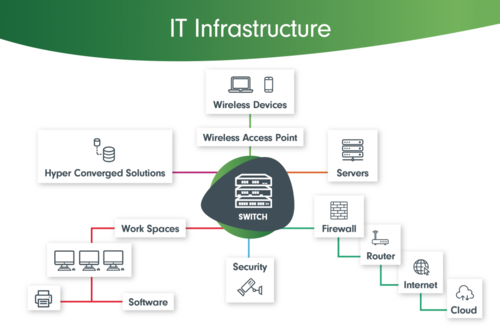IT Infrastructure in UAE
IT Infrastructure refers to the collection of hardware, software, networks, and services that are necessary for the operation and management of an organization's information technology environment. It provides the foundation for the delivery of IT services and supports the overall functioning of an organization.

Hardware components of IT infrastructure include servers, computers, storage devices, networking equipment, and peripherals. These physical devices form the backbone of an organization's IT system and enable the processing, storage, and transmission of data.
Software components encompass operating systems, databases, applications, and other software tools that are used to manage and utilize the hardware resources effectively. These software components enable organizations to perform various tasks, such as data analysis, communication, collaboration, and process automation.
Network infrastructure refers to the interconnected system of devices, protocols, and technologies that enable communication and data transfer within an organization and with external networks. It includes routers, switches, firewalls, and other networking equipment that facilitate the flow of information.
IT services are an essential part of IT infrastructure in UAE and encompass various activities such as system administration, help desk support, network management, cybersecurity, and data backup and recovery. These services ensure the smooth operation and maintenance of the IT environment, as well as provide support to end-users.
In addition to the hardware, software, and network components, IT infrastructure also includes the policies, procedures, and standards that govern the management and use of technology resources. These guidelines help ensure security, compliance, and efficient utilization of IT assets.
A well-designed and robust IT infrastructure is crucial for organizations to effectively manage their data, support business processes, and enable digital transformation. It enhances productivity, enables collaboration, improves communication, and facilitates innovation. Moreover, a reliable and secure IT infrastructure helps protect sensitive information, prevent data breaches, and ensure business continuity.
When developing or upgrading IT infrastructure, organizations need to consider factors such as scalability, reliability, security, and cost-effectiveness. They should align their IT infrastructure strategy with their business goals and future growth plans.
Overall, IT infrastructure forms the backbone of an organization's technology environment, providing the necessary resources and services to support its operations and drive digital transformation.


